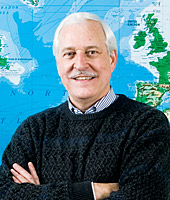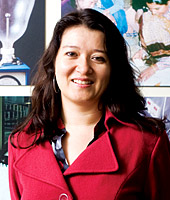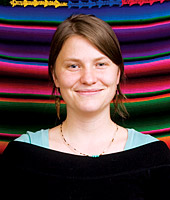The End of Extreme Poverty
Impossible dream or attainable goal?
By Lisa Donegan, SPU Instructor of International Business
Photos by John Keatley

Paul Kennel |
In a presentation for this year’s Day of Common Learning, Seattle Pacific University Instructor Lisa Donegan asked whether ending extreme poverty in our lifetime is an “impossible dream” or an “attainable goal.” For perspective,
she turned to three individuals who know and understand the scourge of global poverty. These experts — representatives of nongovernmental organizations (NGOs) — tell Response what hope means for people who struggle simply to survive.
Paul Kennel, Dime Foundation
The founder and president of Seattle-based Dime Foundation, Paul Kennel is a veteran of international relief and development work. For 25 years, he served with World Concern — first as country manager for Malaysia; later as Asia area director in Bangkok, Thailand; and, from 1995 to 2006, as president. But his international involvement began in 1966 in Vietnam, where he spent seven years providing aid and training to villagers victimized by the Vietnam War. After leaving that country, he engaged in disaster relief in Central America, India, and Bangladesh.
Dime Foundation was born when, in 2006, an investor asked Kennel to design a business model targeting the root causes of extreme poverty. Now Dime is a flourishing NGO that exists to help some of the world’s poorest and most marginalized people lift themselves out of their dire circumstances. The foundation partners with other organizations to provide microloans (small, short-term loans), small-business training, and education — enabling recipients in such countries as Thailand, Ethiopia, and Bolivia to generate “extra” income after paying for food and shelter.
“Poor people in developing countries work extremely hard,” explains Kennel, whose son, Nathan, is a senior at SPU. “‘Extra’ empowers them to make choices.”
Gena Morgan, PATH

Gena Morgan |
Gena Morgan is a special initiatives officer at PATH, an international nonprofit organization with more than 30 years of experience in global health and approximately 650 staff members and 28 offices in 18 countries. PATH aims to improve the health of people in developing countries worldwide by creating health technology programs, strengthening health care systems, and encouraging healthy behaviors.
When Morgan joined PATH in 2007, she brought a wealth of skills gleaned from 10 years working in both for-profit companies and nonprofit organizations, including Microsoft and Agros International. At PATH, she explores new initiatives with a focus on advocacy programs and external relations. One of her first projects targeted meningitis, a disease that kills 10 out of every 100 of its victims and leaves one out of every four survivors with serious neurological damage, but is virtually unknown in the developed world. The Meningitis Vaccine Project aims at developing, rolling out, and evaluating a high-quality, affordable vaccine for the strain of meningitis found in sub-Saharan Africa.
“The goal of this project,” says Morgan, “is to vaccinate at least 80 percent of all 1- to 29-year-olds — at least 9.1 million people — in Burkina Faso within the next two years. In the following years, our plan is to immunize in the remaining Meningitis Belt countries across Africa.”
Christina Cummings, Agros International

Christina Cummings |
With a degree in Spanish and international studies, Christina Cummings joined QUEST (Quaker Experiential Service
Training Program) as an intern in 2006. She was placed at Agros International — an NGO that helps impoverished
families in Mexico and Central America achieve land ownership and build self-sustaining communities. A year later, Cummings signed on as the organization’s full-time international program assistant.
Agros, headquartered in Seattle and founded by 1966 SPU graduate Chi-Dooh “Skip” Li, works to break the cycle of landless poverty by loaning families parcels of land, building materials, and access to integrated irrigation. In turn, the families commit to seven to 10 years of partnership with Agros in order to purchase the land and become economically stable.
Cummings works with Agros’ Guatemala, Honduras,
El Salvador, Nicaragua, and Mexico offices, all staffed by locals. As administrator of a new evaluation system, she helps monitor the communities’ projects and activities. It is work that has given her a new perspective. “It’s common to enter this field,” she says, “thinking you’re going to make a huge difference and contribute to a world of good. But invariably what happens is that the people you’re working with inspire you with their own hard work and hope.”
Is it realistic to think we can end extreme poverty in our time, as Jeffrey Sachs argues in The End of Poverty?
Kennel: Yes. The resources and knowledge are available. However, government policies and personal greed will keep the world from doing it. Each nation wants what it wants and will only address poverty if it is politically advantageous, and helps enhance their basic interests. It will take a sacrifice on everyone’s part — in Western and developing countries — to help those in need.
Morgan: I think it is important to have the dream and the goal of ending extreme poverty; otherwise, we have nothing concrete to work toward. That we are even discussing the end of extreme poverty, that we have specific targets outlined in the Millennium Development Goals, and that there are numerous examples around the world of tremendous progress being made, is unprecedented. Now, more than ever, is the time to believe we can make poverty history.
Cummings: I agree with Gena. If we can visualize a day without extreme poverty, we can achieve it. I recently participated in a workshop where we saw that imagining a peaceful world, then walking backwards to the present, can uncover feasible and concrete actions to achieve that reality. I think that’s how we can
discover our collective roles in ending extreme poverty.
What do you see as the primary obstacles, and the primary sources of hope, in ending poverty?
Kennel: The biggest obstacles are government policies of economics; “my right to have what I want”; businesses not sharing technology about health, agriculture, and water solutions; and the lack of a willingness to work together. Primary sources of hope include the education of children around the world; NGOs that are making a difference and not letting the voice of the poor die out; the poor themselves having a will to help themselves; and governments that help make the playing field more level. I also believe that Christ’s message of hope to the world helps change people’s worldviews, and makes it possible to love their neighbors as themselves.
Morgan: People are both the primary obstacles and the primary sources of hope. People can have short-sighted, self-serving goals. They can lack the political and personal will to find answers to extreme poverty. They can give up hope or allow themselves not to care. But people can also think creatively, motivate others, find the resources, and implement brilliant, enduring solutions.
Cummings: I believe the chief obstacles are corporatization and capitalism, leading to a shrinking middle class, a lack of fair and equal legal and political representation, and a lack of hope and organization among communities to make change. As the chief sources of hope, I see random acts of kindness, growing global activism, and improved technology and communication.
For a person in poverty today, what does hope look like?
Kennel: The poor need a way to support themselves and their families. A way for them to help their children get an education. Opportunities and choices. Government policies and budgets that stop corruption and provide education for all. Access to information. And access to clean water and health care.
Morgan: Hope for people in extreme poverty is all about the future of their children. Will their children live past their fifth birthday, or will they die from an illness or a preventable disease? Can their children go to school and learn how to read and write so that they might have a brighter future? Do they have the opportunity to earn a living wage and support their families? Finding answers to these problems paints a picture of hope.
Cummings: To someone in extreme poverty, hope looks
like a prayer. Until all people have equal access to resources,
a simple prayer is one of the purest demonstrations of hope for
a better world in the future and, unfortunately, all that those in extreme poverty can turn to. We can be a part of the answer to
that prayer.
Return to top
Back to Features Home
|